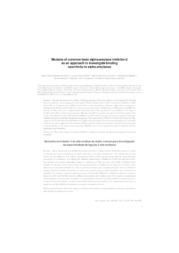Mutants of common bean alpha-amylase inhibitor-2 as an approach to investigate binding specificity to alpha-amylases.
Mutants of common bean alpha-amylase inhibitor-2 as an approach to investigate binding specificity to alpha-amylases.
Author(s): SILVA, M. C. M. da; MELLO, L. V.; COUTINHO, M. V.; RIGDEN, D. J.; NESHICH, G.; CHRISPEELS, M. J.; GROSSI-DE-SÁ, M. F.
Summary: Despite the presence of a family of defense proteins, Phaseolus vulgaris can be attacked by bruchid insects resulting in serious damage to stored grains. The two distinct active forms of a-amylase inhibitors, a-AI1 and a-AI2, in P. vulgaris show different specificity toward a-amylases. Zabrotes subfasciatus a-amylase is inhibited by a-AI2 but not by a-AI1. In contrast, porcine a-amylase is inhibited by a-AI1 but not by a-AI2. The objective of this work was to understand the molecular basis of the specificity of two inhibitors in P. vulgaris (a-AI1 and a-AI2) in relation to a-amylases. Mutants of a-AI2 were made and expressed in tobacco plants. The results showed that all the a-AI2 mutant inhibitors lost their activity against the insect a-amylases but none exhibited activity toward the mammalian a-amylase. The replacement of His33 of a-AI2 with the a-AI1-like sequence Ser-Tyr-Asn abolished inhibition of Z. subfasciatus a-amylase. From structural modeling, the conclusion is that the size and complexity of the amylase-inhibitor interface explain why mutation of the N-terminal loop and resultant abolition of Z. subfasciatus a-amylase inhibition are not accompanied by gain of inhibitory activity against porcine a-amylase.
Publication year: 2004
Types of publication: Journal article
Observation
Some of Embrapa's publications are published as ePub files. To read them, use or download one of the following free software options to your computer or mobile device. Android: Google Play Books; IOS: iBooks; Windows and Linux: Calibre.
Access other publications
Access the Agricultural Research Database (BDPA) to consult Embrapa's full library collection and records.
Visit Embrapa Bookstore to purchase books and other publications sold by Embrapa.

